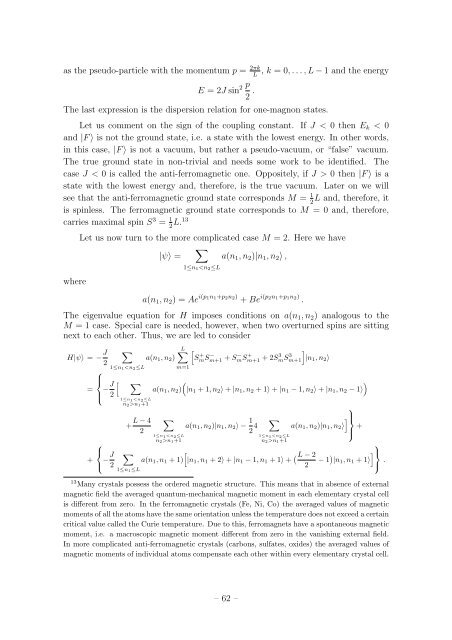Student Seminar: Classical and Quantum Integrable Systems
Student Seminar: Classical and Quantum Integrable Systems
Student Seminar: Classical and Quantum Integrable Systems
Create successful ePaper yourself
Turn your PDF publications into a flip-book with our unique Google optimized e-Paper software.
as the pseudo-particle with the momentum p = 2πk , k = 0, . . . , L − 1 <strong>and</strong> the energy<br />
L<br />
E = 2J sin 2 p 2 .<br />
The last expression is the dispersion relation for one-magnon states.<br />
Let us comment on the sign of the coupling constant. If J < 0 then E k < 0<br />
<strong>and</strong> |F 〉 is not the ground state, i.e. a state with the lowest energy. In other words,<br />
in this case, |F 〉 is not a vacuum, but rather a pseudo-vacuum, or “false” vacuum.<br />
The true ground state in non-trivial <strong>and</strong> needs some work to be identified. The<br />
case J < 0 is called the anti-ferromagnetic one. Oppositely, if J > 0 then |F 〉 is a<br />
state with the lowest energy <strong>and</strong>, therefore, is the true vacuum. Later on we will<br />
see that the anti-ferromagnetic ground state corresponds M = 1 L <strong>and</strong>, therefore, it<br />
2<br />
is spinless. The ferromagnetic ground state corresponds to M = 0 <strong>and</strong>, therefore,<br />
carries maximal spin S 3 = 1 2 L.13<br />
where<br />
Let us now turn to the more complicated case M = 2. Here we have<br />
∑<br />
|ψ〉 = a(n 1 , n 2 )|n 1 , n 2 〉 ,<br />
1≤n 1

















